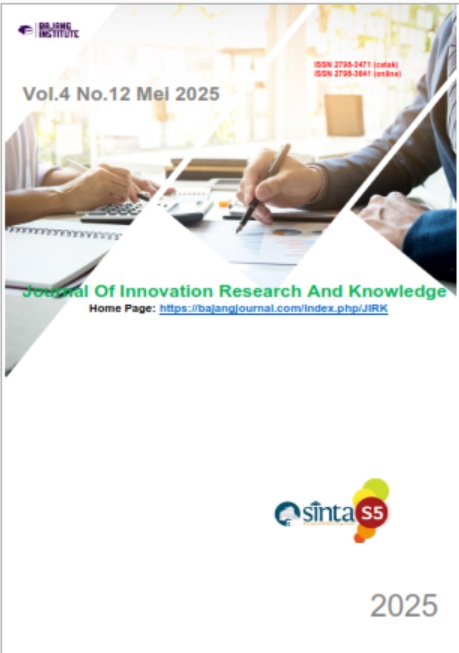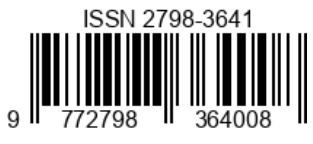UNCOVERING CULTURAL REPRESENTATION IN AN INDONESIAN EFL TEXTBOOK: A CRITICAL DISCOURSE ANALYSIS FOR PROFESSIONAL COMMUNICATION COMPETENCE
DOI:
https://doi.org/10.53625/jirk.v4i12.10234Keywords:
Critical Discourse Analysis, English as a Foreign Language (EFL), Intercultural Awareness, Professional Communication Competence, Textbook Analysis, World EnglishesAbstract
The growing prominence of English as a global lingua franca in professional settings raises concerns about the adequacy of English as a Foreign Language (EFL) textbooks in representing the diversity of World Englishes. This study aims to assess the representation of World Englishes and intercultural awareness in an Indonesian junior high school English as a Foreign Language (EFL) textbook, with a focus on its contribution to enhancing students' professional communication competence. The study employed Critical Discourse Analysis (CDA) to analyze both textual and visual components, alongside the broader social context, to uncover embedded ideologies and power dynamics. The study revealed a primary focus on Inner Circle cultures and Level 1 (Basic Cultural Awareness), with insufficient representation of other English Circles and limited opportunities for critical intercultural engagement. The textbook provides fundamental cultural knowledge but fails to cultivate the intercultural competence required for diverse professional environments. The study signals implications that are examined in relation to textbook developers and teaching practices aimed at enhancing professional communication in a global context
References
Baker, W. (2011). Intercultural awareness: Modelling an understanding of cultures in intercultural communication through English as a lingua franca. Language and Intercultural Communication, 11(3), 197-214. https://doi.org/10.1080/14708477.2011.577779.
Baker, W. (2015a). Culture and identity through English as a lingua franca. Germany: Mouton de Gruyter, Inc.
Baker, W. (2015b). Culture and intercultural communication. In J. Jackson (Ed.), The Routledge handbook of language and intercultural communication (2nd ed., pp. 37-52). England: Routledge.
Barjesteh, H., & Ghaseminia, M. (2023). Effects of pre-listening task types on the development of EFL learners' listening comprehension ability. International Journal of Listening, 37(2), 156-170. https://doi.org/10.1080/10904018.2019.1654867.
Fairclough, N. (1995). Critical discourse analysis: The critical study of language. London: Longman.
Fairclough, N. (2001). Language and Power (2nd ed.). London: Longman.
Fauzi, A., & Dewi, T. A. K. (2024). Cultural representation on the functional grammar exercises in an Indonesian junior high school English textbook. Journal of English Education Program (JEEP), 5(1). https://doi.org/10.26418/jeep.v5i1.71519.
Fauzi, A., & Putra, K. A. (2022). Reconstructing Grammar Exercises: A Systemic Functional Grammar Approach. Tadris: Journal of Education and Teacher Training, 7(2), 397-407. http://dx.doi.org/10.24042/tadris.v7i2.14051.
Gheisari, M., & Akbari, O. (2024). A comparison of cultural representation and ideologies in the multimodal discourses of textbooks used in public and private Iranian contexts: a cross-textual study. Social Semiotics, 34(2), 289-309. https://doi.org/10.1080/10350330.2022.2094234.
Graddol, D. (2006). English next. London: British Council.
Halliday, M. A. K., & Matthiessen, C. (2014). Halliday's introduction to Functional Grammar (4th ed.). Oxon: Routledge.
Kachru, B. B. (1985). Standards, codification and sociolinguistic realism: The English language in the outer circle. In R. Quirk & H. G. Widdowson (Eds.), English in the world: Teaching and learning in the language and literatures (pp. 11-30). Cambridge, England: Cambridge University Press.
Kachru, B. B. (1988). Teaching world Englishes. ERIC/CLL News Bulletin, 12(1), 1-4.
Kachru, B. B. (1992). Teaching world Englishes. In B. B. Kachru (Ed.), The other tongue. English across cultures (2nd ed., pp. 355-365). Urbana, IL: University of Illinois Press.
Kusumaningputri, R., & Widodo, H. P. (2018). Promoting Indonesian university students' critical intercultural awareness in Indonesian tertiary EAL classrooms: The use of digital photograph-mediated intercultural tasks. System, 72, 49-61. https://doi.org/10.1016/j.system.2017.10.003.
McKay, S. (2003). Teaching English as an international language: The Chilean context. ELT Journal, 57(2), 139-148. https://doi.org/10.1093/elt/57.2.139.
Moghaddam, M. M., & Tirnaz, M. H. (2023). Representation of Intercultural Communicative Competence in ELT Textbooks: Global Vs. Local Values. Journal of Intercultural Communication Research. Journal Intercultural Communication Research, 52(2), 191-215. https://doi.org/10.1080/17475759.2022.2152076.
Mulyani, E. R., Widodo, H. P., Simbuka, S., Panjaitan, N. B., & Lestariyana, R. P. D. (2024). A critical discourse analysis of cultural representation in language learning tasks: The case of an English language textbook used in Indonesian secondary schools. Asia Pacific Journal of Education. https://doi.org/10.1080/02188791.2024.2391503.
Rashidi, N., & Meihami, H. (2016). Hidden curriculum: An analysis of cultural content of the ELT textbooks in inner, outer, and expanding circle countries. Cogent Education, 3(1), 1-17. https://doi.org/10.1080/2331186X.2016.1212455.
Sadeghpour, M., & D’Angelo, J. (2022). World Englishes and 'Global Englishes': competing or complementary paradigms? Asian Englishes, 24(2), 211-221. https://doi.org/10.1080/13488678.2022.2076368.
Setyono, B., & Widodo, H. P. (2019). The representation of multicultural values in the Indonesian Ministry of Education and Culture-Endorsed EFL textbook: a critical discourse analysis. Intercultural Education, 30(4). https://doi.org/10.1080/14675986.2019.1548102.
Smith, C., & Sheyholislami, J. (2022). Current trends in critical discourse analysis of textbooks: A look at selected literature. Canadian Journal of Applied Linguistics / Revue Canadienne De Linguistique Appliquée, 25(1), 47-63. https://doi.org/10.37213/cjal.2022.31515.
Widodo, H. P. (2015). Textbook analysis on college academic writing. TEFLIN Journal, 18(2), 109-122. https://doi.org/10.15639/teflinjournal.v18i2/109-122
Widodo, H.P., Fang, F., & Elyas, T. (2022). Designing English language materials from the perspective of Global Englishes. Asian Englishes, 24(2), 186-198. https://doi.org/10.1080/13488678.2022.2062540.
Wodak, R., & Meyer, M. (2009). Methods for Critical Discourse Analysis (2nd ed.). London: SAGE Publications.
Zhang, H., Li, X., & Cheng, W. (2024). Representation of cultures in national English textbooks in China: a synchronic content analysis. Journal of Multilingual and Multicultural Development, 45(8). https://doi.org/10.1080/01434632.2022.2099406.















